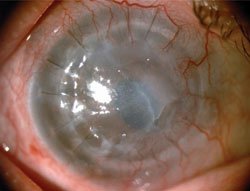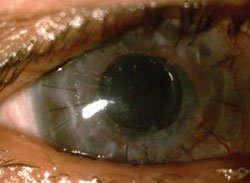Foldable artificial cornea may provide another option for corneal transplantation
The device does not penetrate the anterior chamber, and implantation requires 5% corneal tissue removal.
 Thomas John |
Corneal transplantation has been practiced for more than 100 years to restore vision to individuals all over the world. However, such transplantation is dependent on the continued availability of donor corneas.
Globally, there is a significant mismatch between the number of individuals with corneal blindness and the number of available donor corneas. Corneal blindness ranks as the fourth leading cause of blindness globally, following cataract, glaucoma and macular degeneration, according to the World Health Organization. In order to solve this problem of supply and demand, we have to consider new avenues, entailing a paradigm shift from tissue-dependent to tissue-independent corneal transplantation.
Such a paradigm shift will require a greater dependency on artificial corneas. This poses the challenge of solving problems associated with biointegration of artificial corneas and their secondary effects, including glaucoma, corneal melt, infectious keratitis, retroprosthetic membranes and endophthalmitis. Solving these issues requires an amalgamation of basic biomaterial research and clinical evaluations. The doors to tissue-independent corneal transplantation will be fully open only once these issues are solved or significantly diminished.
In the arena of artificial corneas, various devices have been developed, and the current models include the Boston K-Pro and the AlphaCor artificial cornea (Addition Technology). The Boston K-Pro has shown significant clinical acceptance among corneal surgeons worldwide.
In this column, Drs. Vargas and Shiuey describe their initial results with the new KeraKlear (KeraMed) artificial cornea, which is the first foldable artificial cornea. The KeraKlear is not approved by the U.S. Food and Drug Administration. Close clinical monitoring of the KeraKlear over an extended period of time is mandatory to evaluate the overall safety and efficacy of this device.
Thomas John, MD
OSN Surgical Maneuvers Editor
The KeraKlear from KeraMed is a new type of foldable artificial cornea that is designed for synthetic anterior lamellar keratoplasty through small incisions. The KeraKlear is able to restore vision by replacing the anterior portion of the cornea, in which the majority of the focusing of light rays occurs. This device is implanted into a femtosecond laser-created lamellar corneal pocket with an 8-mm diameter after the removal of the central anterior cornea. Posterior cornea with the patient’s endothelium is retained, and it is thought to avoid a number of common complications of other artificial corneas, including endophthalmitis and retroprosthetic membranes. The KeraKlear is made of a proprietary biocompatible material that is sufficiently flexible (Figure 1) to be implanted through a 3-mm incision using forceps. The optic diameter is 4 mm, which provides a large enough optical zone to afford a full visual field and a good view of the fundus.
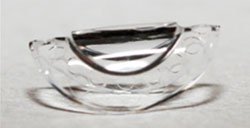 Figure 1. Foldable artificial cornea. Images: John T, Vargas JM, Shiuey Y
|
Dr. Shiuey, the inventor of KeraKlear, recognized the need for an artificial cornea that would be simple to use in the absence of donor tissue. This artificial cornea merges the principles of small-incision cataract surgery and femtosecond laser refractive surgery. The result is an artificial cornea procedure that can be learned easily and provides rapid recovery for the patient.
Dr. Vargas, of Valencia, Venezuela, has used the KeraKlear in 10 patients with corneal graft rejection, corneal scars and keratoconus. He and his patients have been very pleased with the results of the KeraKlear. The improvement in vision has been immediate, and he also likes that in the event of a complication, he could still perform penetrating keratoplasty because only 5% of the patient’s corneal tissue is removed as part of the KeraKlear procedure.
Case 1
A patient with a history of two failed cornea transplants secondary to endothelial rejection and hand motion vision underwent the KeraKlear procedure. On day 1 after surgery, his uncorrected vision was 20/100 and he could read large print (Figure 2). Additionally, on postop day 1, the iris details were visible through the artificial cornea (Figure 3) and the fundus could be visualized (Figure 4). At 1 month, uncorrected vision improved to 20/60. Results have remained stable over 6 months.
|
|
|
|
Figure 2. Preoperative and postoperative
photographs after KeraKlear procedure. |
|
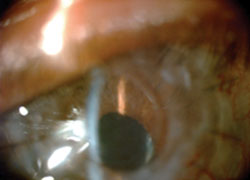 Figure 3. On day 1 after KeraKlear procedure, the iris details are visible. |
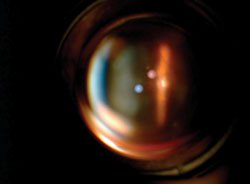 Figure 4. Fundus visualization is possible on day 1 after KeraKlear procedure. |
Case 2
A patient had keratoconus, apical scarring and preoperative vision of 20/400. After the KeraKlear procedure, uncorrected vision improved to 20/30 on postoperative day 1 (Figure 5).
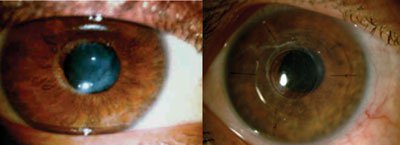 Figure 5. Preoperative and postoperative day 1 appearance of a keratoconus cornea after KeraKlear procedure. |
Advantages of procedure
A key factor in the success of this procedure has been the use of the femtosecond laser to create the corneal pocket. When a surgeon manually dissects a corneal pocket, it is not possible to accurately create a pocket of consistent depth, which may lead to complications. Moreover, for cases in which the cornea is thin, such as with keratoconus, the accuracy of the femtosecond laser is even more critical. Dr. Vargas has used the Ziemer LDV Crystal Line laser for implantation of the KeraKlear in cases of keratoconus and has found that using the femtosecond laser makes the procedure fast and predictable.
Traditionally, artificial corneas have been considered the last-line option because of difficult surgery and the risks of serious complications. Because the KeraKlear can be implanted with removal of only 5% of corneal tissue and does not penetrate into the anterior chamber, it may be suitable as a first-line procedure, especially in many places worldwide where corneal tissue is difficult to obtain. Additionally, implantation of the KeraKlear does not appear to affect IOP, and measurement of IOP is possible with a Tono-Pen (Reichert) applied to the peripheral cornea. The Table shows a list of potential advantages of the KeraKlear compared with traditional PK.
As is the case with other artificial corneas, the KeraKlear requires daily use of antibiotic drops such as moxifloxacin 0.5% and vancomycin 14 mg/mL twice daily for the prevention of infection. Other commercially available antibiotics may also be used. However, daily steroids for the prevention of rejection are not necessary as is usually the case with PK. The lack of chronic steroid use helps to avoid the complications of glaucoma and cataract formation. A bandage contact lens such as the Kontur Precision Sphere is also suggested to help protect the interface between the KeraKlear and the recipient cornea.
The KeraKlear has received European CE mark approval but is not cleared for use in the United States.
References:
- Colby KA, Koo EB. Expanding indications for the Boston keratoprosthesis [published online ahead of print May 2, 2011]. Curr Opin Ophthalmol. doi: 10.1097/ICU.0b013e3283477d0d.
- Gomaa A, Comyn O, Liu C. Keratoprostheses in clinical practice – a review. Clin Experiment Ophthalmol. 2010;38(2):211-224.
- Hartmann L, Watanabe K, Zheng LL, et al. Toward the development of an artificial cornea: Improved stability of interpenetrating polymer networks [published online ahead of print April 18, 2011]. J Biomed Mater Res B Appl Biomater. doi:10.1002/jbm.b.31806.
- Pineda R II, Shiuey Y. The KeraKlear artificial cornea: A novel keratoprosthesis. Tech Ophthalmology. 2009;7(3):101-104.
- Thomas John, MD, is a clinical associate professor at Loyola University at Chicago and is in private practice in Oak Brook, Tinley Park and Oak Lawn, Ill. He can be reached at 708-429-2223; fax: 708-429-2226; email: tjcornea@gmail.com.
- Yichieh Shiuey, MD, can be reached at 408-752-0850; email: yshiuey@keramed.com.
- Jose M. Vargas, MD, can be reached at 58-241-8246064; email: corneavargas@me.com.
- Disclosures: Dr. John has no financial interest in any aspect of this article. Dr. Shiuey is the inventor of the KeraKlear and has a financial interest in this device. Dr. Vargas is a paid consultant for KeraMed.

